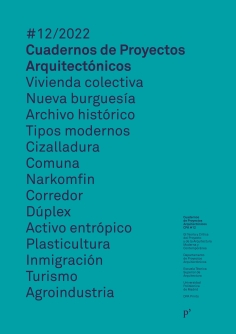The ‘capacity for action’ of architectural spaces: open system design strategies
DOI:
https://doi.org/10.20868/cpa.2022.12.4964Palabras clave:
Estrategias proyectuales arquitectónicas, Nuevas domesticidades, Inclusividad, Capacidad de acción, Reprogramación, Architectural design strategies, New domesticities, Inclusivity, Capacity for action, ReprogrammingResumen
Resumen
Este texto abarca la búsqueda de estrategias proyectuales eficaces para ampliar la 'capacidad de acción' de los espacios que proyectamos los arquitectos. Investiga cómo proyectar arquitectura para facilitar la capacidad performativa de los habitantes y usuarios, ampliando su acción y también su responsabilidad como coproductores de nuestras propuestas. Se trabaja en arquitecturas de Sistemas Abiertos más que en proyectos participativos, es decir, desde la invitación a la acción para apropiarse de los espacios en el tiempo y poder reprogramarlos y no tanto desde la implicación inicial de los usuarios como agentes en el proyecto. La exploración está destinada tanto a arquitectos proyectistas y profesores de diseño como a los propios usuarios, de modo que se facilite el conocimiento y aplicación de estos sistemas abiertos en los proyectos. Estas estrategias se discuten, heredando clasificaciones comparables realizadas por otros autores, y finalmente se organizan en tres grupos: redundancia, apropiación y tecnificación, que se ordenan según gradientes de complejidad constructiva o facilidad de uso. Se registran en un diagrama numerosos ejemplos de arquitectura para comprobar la efectividad de esta taxonomía. El diagrama es una categorización no jerarquizada en la que los asuntos y los casos de estudio tienen el mismo valor. Se trata simultáneamente de una taxonomía y un atlas de métodos y casos, un proceso al mismo tiempo deductivo e inductivo. Se prevé dejar este diagrama abierto para poder ser reprogramado en el futuro, acorde a las propias arquitecturas que se estudian.
Abstract
This text aims to identify which design strategies are more effective in increasing the “capacity for action” of the spaces designed by architects. It researches how architectural design can foster the performative capacity of the inhabitants and users, widening their actions and responsibilities as co-producers of our proposals. The exploration is aimed both at practicing architects and design teachers as well as the actual users, making these open systems available to be used and harness the potential of working together. The strategies are discussed, taking on similar classifications from other authors, and lastly organized into three group types: redundancy, appropriation, and technification, further organized according to constructive complexity or ease of use. A large number of examples of built architecture are represented in a diagram to test the effectiveness of this taxonomy. The diagram is a non-hierarchical categorization where the matter and the case studies are given equal weighting; it is simultaneously a taxonomy and an atlas of methods and cases, a process at once deductive and inductive. The diagram will be left open to be reprogrammed in the future, much like the architectures studied.
Descargas
Referencias
Schneider Tatjana. Spatial Agency. Other ways of doing architecture. London: Routledge, 2011. https:// www.spatialagency.net/.
Forty, Adrian. Words and Buildings. A vocabulary of Modern Architecture. United Kingdom: Thames and Hudson, 2000.
Giedion, Sigfrido. Espacio, tiempo y arquitectura. El futuro de una nueva tradición. Madrid: Dossat. Quinta Edición, 1978.
Habraken, John. Soportes: una alternativa al alojamiento de masas. Madrid: Alberto Corazon, 1976, traducido por Fernando Ramón. "Supports: An Alternative to Mass Housing. London": The Architectural Press 1972. Originalmente publicado en neerlandés: De Dragers en de Mensen. Amsterdam: Scheltema en Holkema, 1962.
Ito, Toyo. "Paisaje arquitectónico de una ciudad envuelta en plástico transparente" en Escritos. Murcia: Colegio Oficial de Aparejadores y Arquitectos Técnicos de Murcia, 2000.
Kendal, Stephen and Teicher Jonathan. Residential Open Building. London: cib International Council for Building Research Studies and documentation, 2000.
Kieran, Stephen and Timberlake James. Refabricating architecture. How manufacturing methodologies are poised to transform building construction. New York: McGraw-Hill, 2004
Lucas, Patricia. "PREVI, Lima. La arquitectura del tiempo y sus gestión" en Post-domesticity. Rethinking urban obsolescence. Ed. Diego García-Setién et alt. 84-91. Barcelona: Actar, 2022.
Palacios, Luis. "El crecimiento (no) programado de la Vivienda" en Post-domesticity. Rethinking urban obsolescence. Ed. Diego García-Setién et alt, 108-117. Barcelona: Actar, 2022.
Ratti, Carlo and Claudel Matthew. Open-source Architecture. United Kingdom: Thames and Hudson, 2015.
Sánchez, José Antonio. "Dramaturgia en el campo expandido". En VVAA Repensar la dramaturgia. Errancia y transformación. CENDEAC Centro Párraga, Murcia 2011. 7-27 http:// archivoartea.uclm.es/ textos/dramaturgia-en-el- campo-expandido/
Sarkis, Hashim. "How will we live together?" Statement. 17ª Biennale Architettura 2021, Biennale di Venezia. 2021. https:// www.labiennale.org/en/ architecture/2021
Schneider, Tatjana and Till, Jeremy "Flexible housing: the means to the end" en Cambridge Journals, theory, arq, vol 9, nos 3,4, 2005. https://www.cambridge.org
Till, Jeremy and Schneider, Tatjana. Flexible Housing. London: Routledge, 2007.
Till, Jeremy and Schneider, Tatjana. "Flexible housing: opportunities and limits" en Cambridge Journals, theory, arq, vol 9, no 2, 2005 https:// www.cambridge.org
Descargas
Publicado
Número
Sección
Licencia
1. Los autores conservan los derechos de autor y garantizan a la revista el derecho de una Licencia Creative Commons Atribución-NoComercial-SinDerivar 4.0 Internacional que permite a otros compartir el trabajo con un reconocimiento de la autoría.
2. Los autores pueden establecer por separado acuerdos adicionales para la distribución no exclusiva de la versión de la obra publicada en la revista (por ejemplo, situarlo en un repositorio institucional o publicarlo en un libro).












